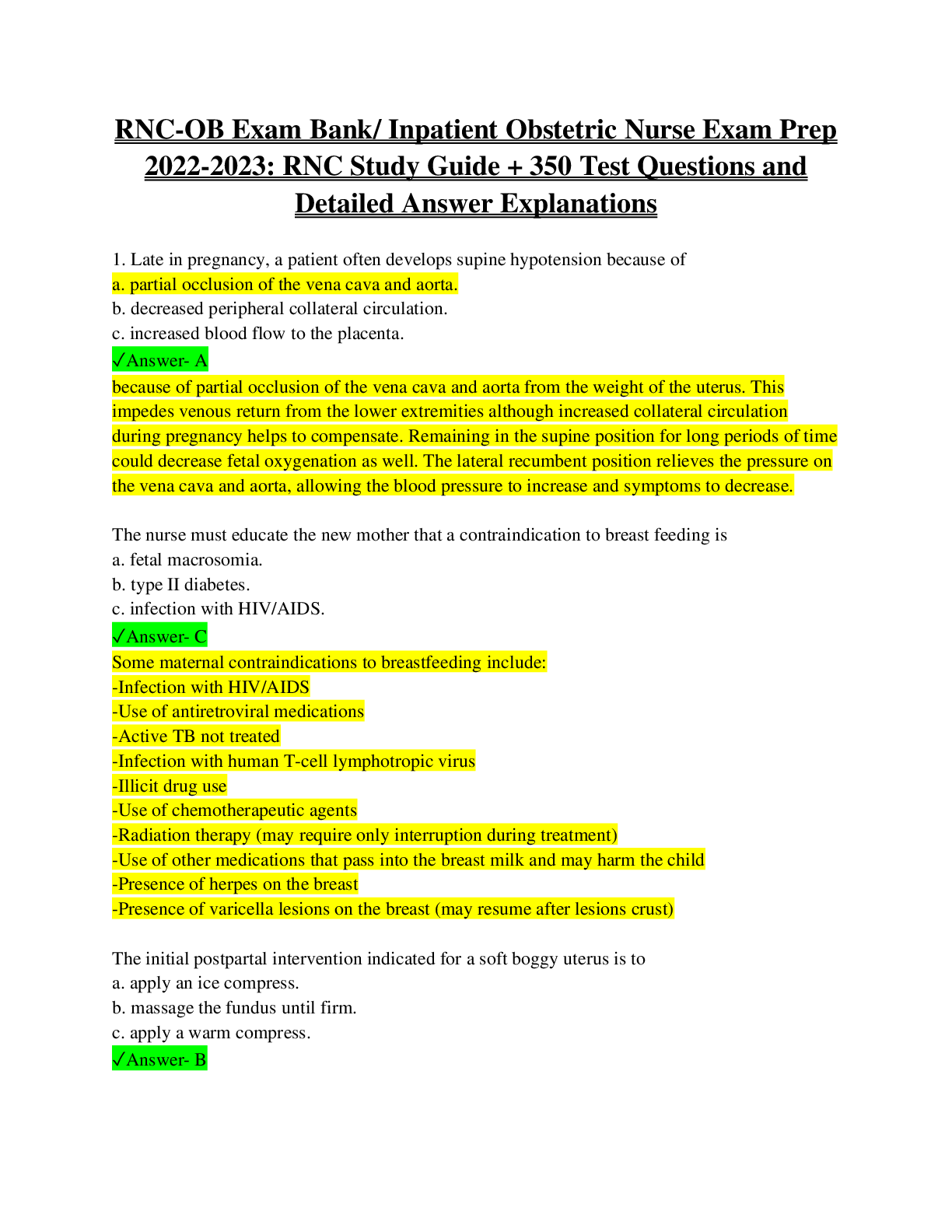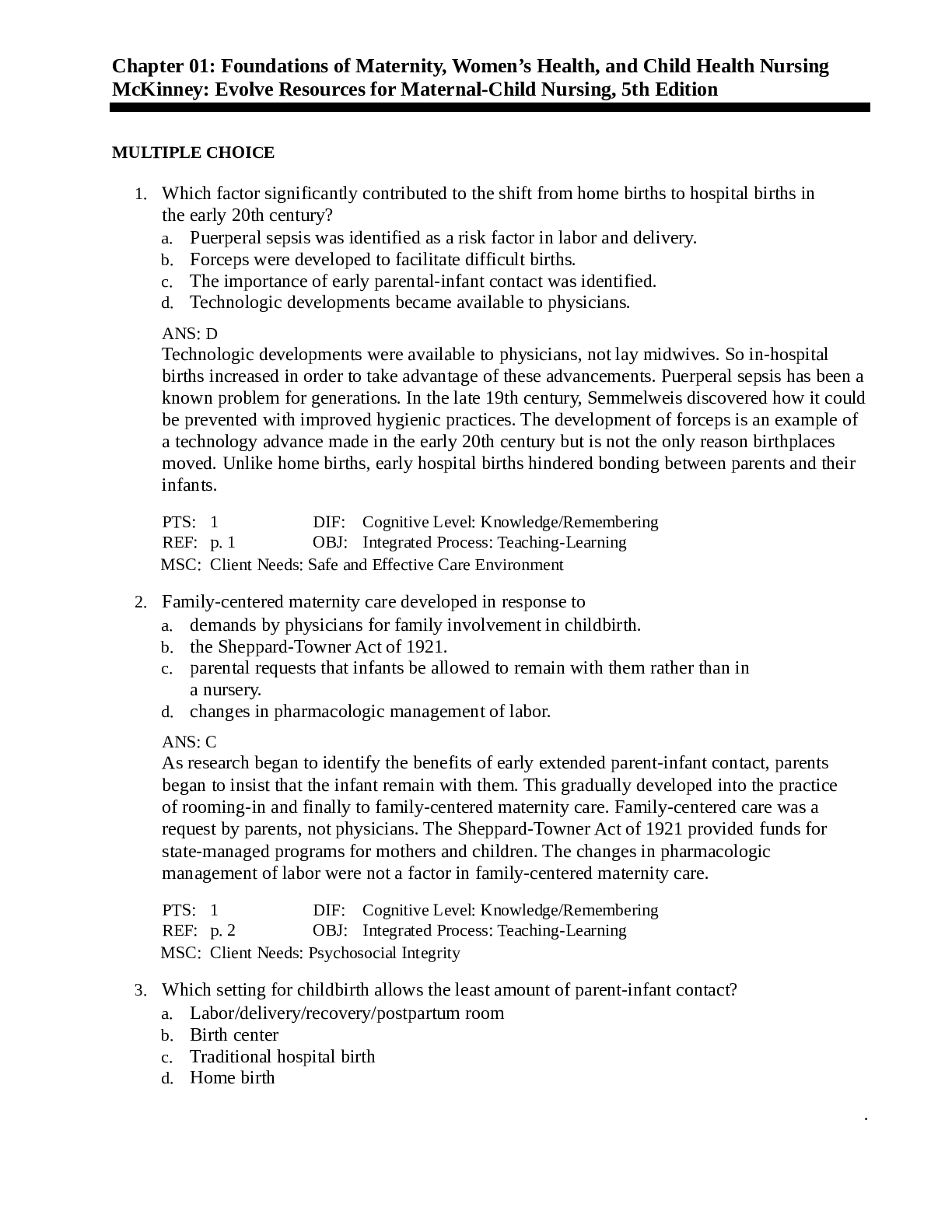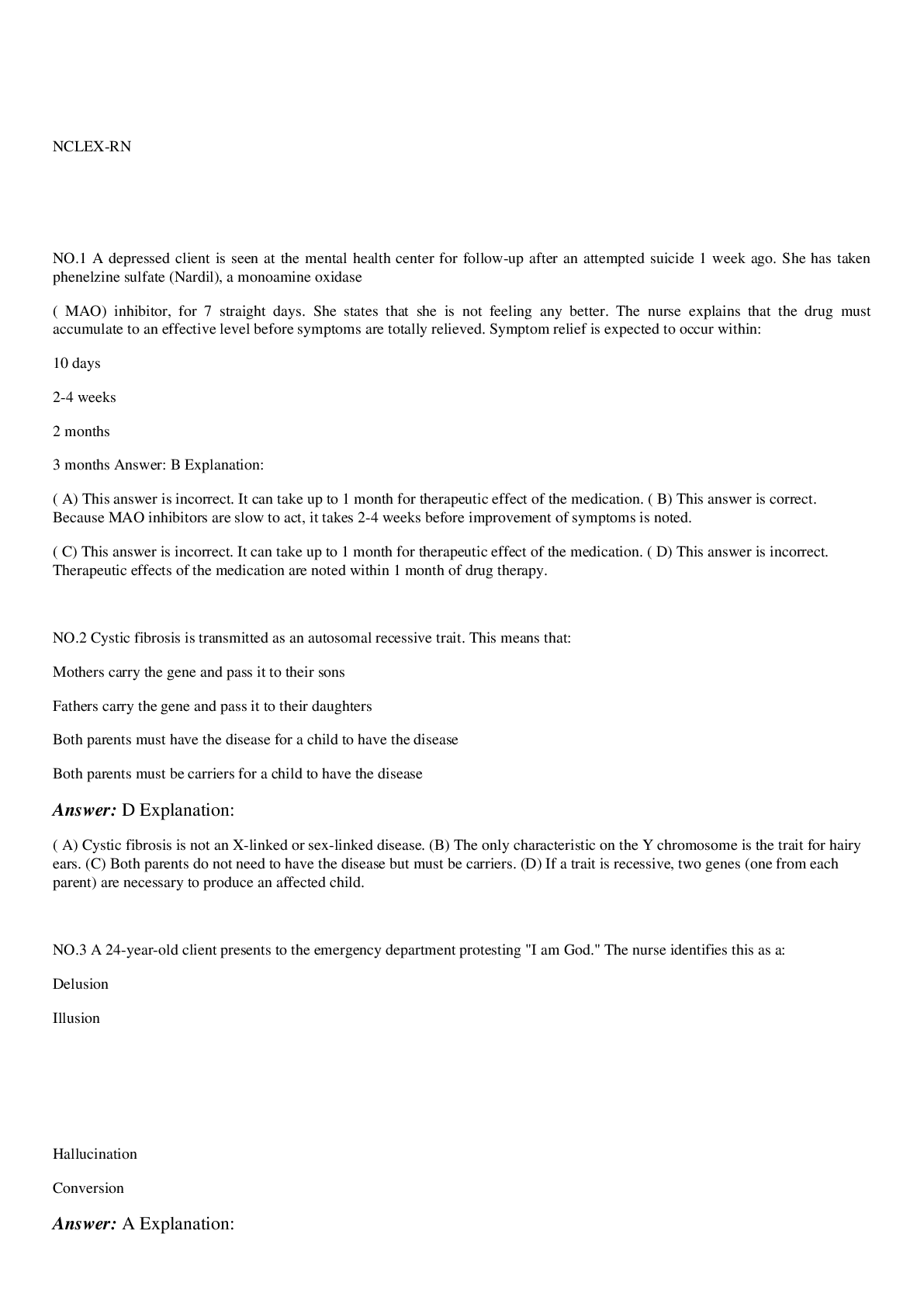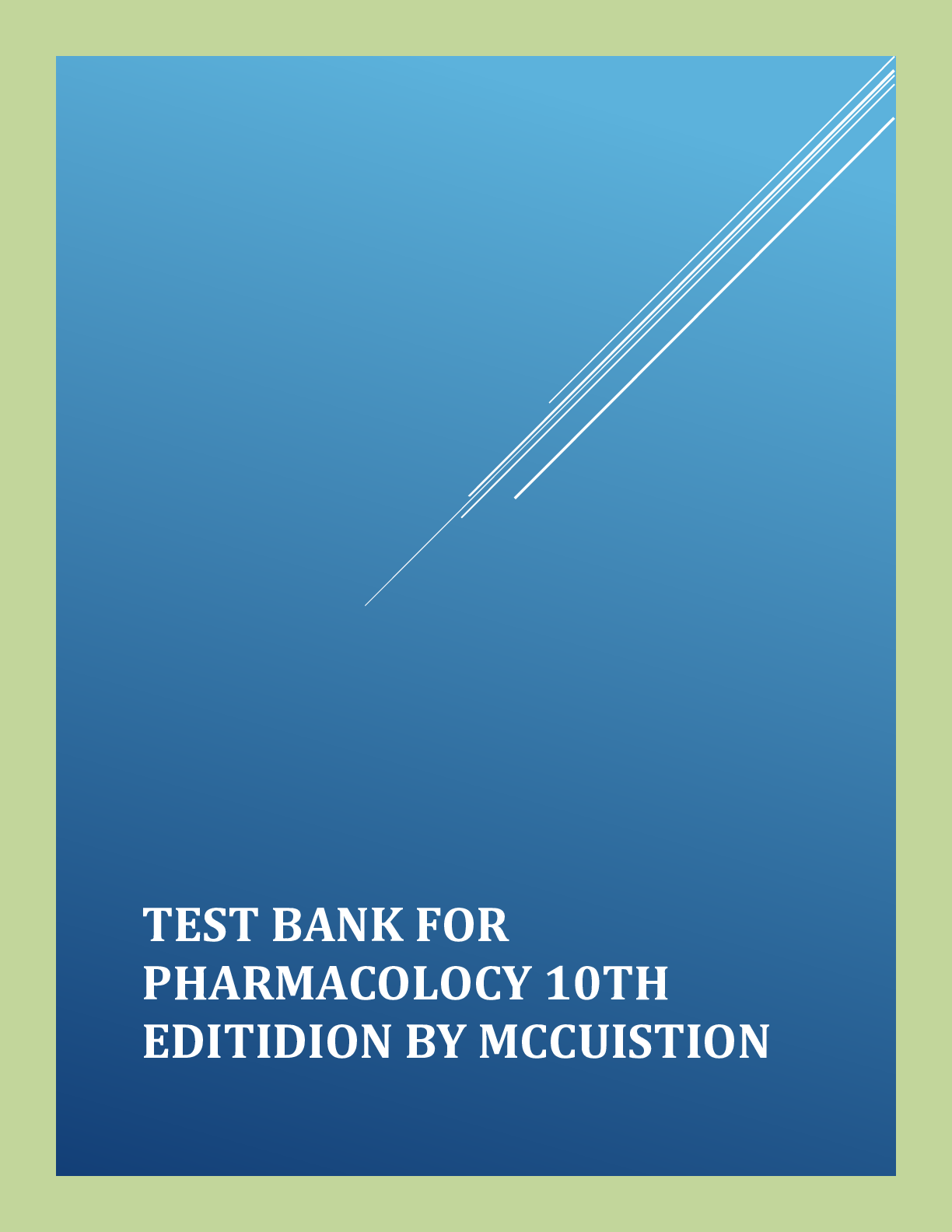Obstetrics > TEST BANKS > RNC-OB Exam test bank | Inpatient Obstetric Nurse Exam Prep : RNC Study Guide + 350 Test Question (All)
RNC-OB Exam test bank | Inpatient Obstetric Nurse Exam Prep : RNC Study Guide + 350 Test Questions and Detailed Answer Explanations.
Document Content and Description Below
RNC-OB Exam test bank 2022 | Inpatient Obstetric Nurse Exam Prep 2022-2023: RNC Study Guide + 350 Test Questions and Detailed Answer Explanations. 1. Late in pregnancy, a patient often develops supin... e hypotension because of a. partial occlusion of the vena cava and aorta. b. decreased peripheral collateral circulation. c. increased blood flow to the placenta. ✓Answer- A because of partial occlusion of the vena cava and aorta from the weight of the uterus. This impedes venous return from the lower extremities although increased collateral circulation during pregnancy helps to compensate. Remaining in the supine position for long periods of time could decrease fetal oxygenation as well. The lateral recumbent position relieves the pressure on the vena cava and aorta, allowing the blood pressure to increase and symptoms to decrease. The nurse must educate the new mother that a contraindication to breast feeding is a. fetal macrosomia. b. type II diabetes. c. infection with HIV/AIDS. ✓Answer- C Some maternal contraindications to breastfeeding include: -Infection with HIV/AIDS -Use of antiretroviral medications -Active TB not treated -Infection with human T-cell lymphotropic virus -Illicit drug use -Use of chemotherapeutic agents -Radiation therapy (may require only interruption during treatment) -Use of other medications that pass into the breast milk and may harm the child -Presence of herpes on the breast -Presence of varicella lesions on the breast (may resume after lesions crust) The initial postpartal intervention indicated for a soft boggy uterus is to a. apply an ice compress. b. massage the fundus until firm. c. apply a warm compress. ✓Answer- B ...with the dominant hand while supporting the inferior uterus with the non-dominant hand to prevent trauma. If the fundus does not contract with massage, then further evaluation is indicated to determine if placental fragments remain. After the fundus becomes contracted, the nurse should push firmly downward on the fundus to expel clots that may have pooled. With the vibroacoustic stimulation test, stimulus with an artificial larynx or other device is applied to the maternal abdomen for a. 1 to 3 seconds. b. 5 to 10 seconds. c. 1 to 2 minutes. ✓Answer- A Usually, stimulus is applied for 1-2 seconds and repeated up to 3 times with time extending to 3 seconds in order to stimulate fetal movement. A positive or reactive finding is an increased fetal heart rate of 15 bpm or more for at least 15 seconds; however, a nonreactive result does not always indicate fetal abnormality but indicates the need for further testing. Absence of the Moro reflex on one side only in a neonate may indicate a. fractured scapula. b. cerebral palsy. c. fractured clavicle. ✓Answer- C a fractured clavicle or brachial plexus injury. Damage to the central nervous system, such as may occur with cerebral palsy, often results in bilateral absence of the reflex. The Moro reflex is elicited by allowing the infant's head and trunk to fall slightly backward when the infant is raised. A positive Moro reflex includes immediate extension and abduction of the arms(and sometimes the legs) with fingers fanning and forming a C-shape with a return of the limbs to the flexed states In a multiparous woman, what is the lowest Bishop score that predicts labor induction will be successful? a. 5 b. 7 c. 9 ✓Answer- A In a multiparous woman, the Bishop score that predicts that labor induction will be successful is 5 or more while it is a 9 or more for a nulliparous woman. The Bishop score is a rating system to determine readiness for induction based on scores of 0-3 in four different measures: dilation (cm), effacement (percentage), station (cm), and cervical consistency (firm, medium, soft), and cervical position (posterior, mid position, anterior). The fifth measure, cervical position, is scored only 0-2. When cervical laceration occur during delivery, they are most common at what position? a. 3 and 9 o'clock b. 12 and 6 o'clock c. 10 and 4 o'clock ✓Answer- A Cervical lacerations are most often identified with vaginal retractors when bleeding is persistent after delivery. The lacerations are sutured with absorbable sutures, so no further treatment is usually indicated. Minor lacerations often occur during delivery, but they usually require no treatment. Tears are more common after forceps assisted and vacuum assisted deliveries than normal vaginal births If using fetal pulse oximetry, what is normal oxygen saturation? a. 30% to 65% b. 65% to 90% c. 90% to 100% ✓Answer- A because of the fetus's high hemoglobin and hematocrit. A value below 30% may be associated with hypoxia and metabolic acidosis. For fetal pulse oximetry, which may be used to determine whether immediate intervention is needed for non-reassuring fetal heart rate, a special single-use sensor is placed internally along the fetal cheek, temple, or forehead. However, fetal pulse oximetry has not been found to reduce overall rates of Caesarean. A decrease of fetal heart rate of at least 15 bpm for at least 10 minutes is classified as a. recurrent deceleration. b. prolonged deceleration. c. baseline change. ✓Answer- C If it persists more than 2 minutes but less than 10 minutes, it is classified as a prolonged deceleration. Recurrent decelerations are classified as occurring with half or more of uterine contractions in a 20 minute period. Intermittent decelerations occur with fewer than half of uterine contractions in a 20 minute period. With suspected fetal hypoxia, a cord blood gas specimen is obtained during delivery by a. withdrawing blood from the vein/artery before the cord is clamped or cut and before placental expulsion. b. placing one clamp and withdrawing blood above the clamp before cutting the cord. c. double clamping a 10 to 20 cm segment, cutting it out, and then withdrawing blood from the segment. ✓Answer- C The segment can be placed on ice temporarily as cord blood gas can be accurately assessed for 60 minutes. An arterial sample is preferred over venous, but paired sampling is recommended. A pH of 7.24 or less is associated with neurological compromise. A base excess of 12 mmol/L or more is predictive of motor or cognitive impairment. When eliciting the scarf sign in a neonate, the infant's elbow crosses the midline of the chest, probably indicating a a. preterm infant. b. term infant. c. postterm infant. ✓Answer- A At fullterm, the elbow should not cross the midline. For the scarf test, the neonate should be placed supine. One arm is grasped and the hand pulled toward the opposite shoulder and then the position of the elbow is assessed in relation to the midline of the chest. Following birth, which hormone stimulates the alveolar cells of the breast, promoting production of milk? a. Estrogen b. Prolactin c. Progesterone ✓Answer- B which increases in response to the neonate's suckling. Suckling also promotes release of oxytocin, which promotes the letdown reflex by increasing contractibility of the muscles of the mammary ducts. After milk production is well established, prolactin levels decrease, and most milk production is then facilitated by oxytocin. During pregnancy, estrogen promotes proliferation of breast ducts and progesterone the development of lobules and alveoli Which anesthetic technique provides the best relief of pain during labor and delivery? a. Epidural b. Spinal c. Pudendal block ✓Answer- A The epidural can provide continuous relief during both labor and delivery and does not pose the risk of spinal headache and provides less motor blockade. Additionally, there is a deceased risk of hypotension because of reduced risk of sympathetic blockade. Spinal is now usually reserved for Cesareans. The pudendal block provides relief primarily during delivery. A patient with lupus erythematosus places the fetus at risk if she takes which medication during pregnancy? a. Prednisone b. Methotrexate c. Plaquenil® (hydroxychloroquine) ✓Answer- B ...methotrexate or cyclophosphamide. Both of these medications should be discontinued at least 30 days prior to the patient becoming pregnant. Plaquenil and prednisone may be continued during pregnancy. A patient with lupus should be stabilized for at least 6 months before attempting to become pregnant because pregnancy may exacerbate symptoms, and the patient may have antibodies that increase risk of miscarriage or stillbirth in late pregnancy. A series of ultrasound scans after the 20th week show that the fetal head is growing normally but the abdominal circumference is lower than expected. This may indicated which of the following? a. Down syndrome b. Neural tube defect c. Placental insufficiency ✓Answer- C ...common in patients who are diabetic, hypertensive, or anemic. With placental insufficiency, the supply of oxygen and nutrients to the fetus is impaired, so the fetus responds by sending the nutrients to the most critical organs (heart, brain, lungs) and the other abdominal organs receive less, so they develop more slowly Idiopathic cardiomyopathy of pregnancy is a condition that a. precedes pregnancy and exacerbates due to the stress of pregnancy. b. develops in the last month of pregnancy or soon after birth without preexisting cardiac disease. c. develops in the first trimester of pregnancy and must be monitored throughout the pregnancy and delivery. ✓Answer- B Develops in the last month of pregnancy or the first 5-6 postpartal months and is not associated with pre-existing myocarditis, endocarditis, or cardiac disease. It is characterized by left ventricular systolic dysfunction. Typical symptoms are similar to heart failure and include dyspnea (the most common symptom), orthopnea, cough, palpitations, and chest pain. The heart is markedly enlarged, and the ejection fraction is less than 45%. It increases risk of thromboembolia, so the woman is often treated with heparin. Treatment is similar to that for heart failure although if it occurs prior to delivery, ACE inhibitors are withheld because of adverse effects to the fetus. Management includes bedrest, diuretics, and digoxin. If 10% to 20% of the placental surface is detached but the mother and fetus are not in distress, the placental abruption is classified as a. grade 1, mild. b. grade 2, moderate. c. grade 3, severe. ✓Answer- A Grade 1: 10-20% of the placental surface is detached o the mother and fetus are not in distress. Uterus may be tender and mild tetany evident Grade 2: 20-50% is detached with or without external bleeding. Uterine tenderness and tetany are evident. While the mother is not in shock, the fetus shows distress. Grade 3: over 50% detached with severe uterine tetany, maternal shock, and frequently coagulopathy. The fetus is dead. If vaginal fluid contains blood, the nitrazine test for the presence of amniotic fluid a. may show a false positive. b. may show a false negative. c. is unaffected by blood. ✓Answer- A because the pH of blood ranges from 7.35-7.45 and the pH of amniotic fluid ranges from 7.0-7.5, so they may react similarly. A pH in the range of 6.57.5 is considered positive for amniotic fluid in the absence of other factors (blood, semen, urine) that may affect results. The test sample should include vaginal secretions from the posterior vagina but not the mucous plug To reduce the risk of hemorrhagic disease after birth, a neonate should receive a. vitamin B9 (folic acid). b. vitamin C. c. vitamin K. ✓Answer- C Neonates are born with low levels of vitamin K, which is necessary to activate clotting factors. Additionally, while platelet levels are near adult level, the platelets do not respond effectively to stimuli for several days after birth. Combined, these factors increase the risk of hemorrhage, but the risk is markedly reduced if the neonate receives an IM injection of vitamin K. A patient is in active labor and has contractions every 8 minutes lasting for 45 seconds and increasing in intensity by 25 mm Hg during contractions. This patient is likely experiencing a. hypertonic labor. b. hypotonic labor. c. normal labor. ✓Answer- B The average amplitude is 40-50 mmHG. Because the contractions are often irregular and have low amplitude, cervical dilation is usually slowed or may arrest so that labor becomes prolonged without interventions. Treatment may include ROM and/or oxytocin to strengthen the contractions A pregnant patient who presents with sudden onset of severe uterine pain with slow increase in fundal height but no vaginal bleeding should be assessed for a. abruptio placentae. b. bladder retention. c. fecal impaction. ✓Answer- A Up to 80% of patients with abruptio placentae exhibit vaginal bleeding, but bleeding may be contained between the uterine wall and the placenta, resulting in maternal shock without obvious bleeding. If the fetus is at term, bleeding is severe, or the mother or fetus is in jeopardy, immediate delivery is indicated. During the second stage of labor, when does external rotation occur? a. As the fetus descends from station 2+ to 4+ b. Before delivery of the head c. After delivery of the head ✓Answer- C The head is delivered face down but then externally rotates so that the face is toward the right or left (facing maternal inner thighs) in order to allow passage of the shoulders and body. If shoulder dystocia occurs, delivery may halt at this time. McRoberts technique, in which the patient elevates the knees to the chest position, may reduce the angle and allow expulsion. Supporting a patient's request that she receive an opioid and an epidural during labor is an example of the ethical principle of a. autonomy. b. beneficence. c. justice. ✓Answer- A ...which recognizes that people have the right to make their own decisions about care. Beneficence is taking action that benefits another, such as providing pain relief immediately when needed. Justice requires fair and equal treatment of all, making sure that resources and health care are distributed in a fair manner. What is a contraindication of oxytocin infusion? a. Eclampsia b. Non-reassuring fetal heart rate c. Dystocia ✓Answer- B Other contraindications include cephalopelvic disproportion, transverse lie, placenta previa, vasa previa, previous classic uterine incision or uterine surgery, and invasive carcinoma of the cervix. Oxytocin is used to stimulate uterine contractions, thus inducing or augmenting labor, and may be indicated for suspected fetal jeopardy, dystocia, postterm pregnancy, eclampsia, fetal death, chorioamnionitis, and multiple maternal medical problems, such as renal disease or uncontrolled diabetes mellitus If the biophysical profile shows a score of 8 with normal amniotic fluid volume, what is the required intervention? a. No intervention needed b. Induction of labor c. Repeat test the same day ✓Answer- A A normal BPP is 10 (score of 2 on 5 different measures). A score of 8 with normal AFI suggests very little risk to the fetus and no intervention is required. If however, the amniotic fluid volume were abnormal, this would suggest chronic asphyxia and increased rate of perinatal mortality within a week, so birth should be induced. A score of 6 indicated possible asphyxia, 4 probably asphyxia, 2 almost certain asphyxia, and 0 certain asphyxia For an elective Caesarean, the most important preoperative measure is to a. determine the method of anesthesia. b. position the patient correctly. c. confirm fetal maturity. ✓Answer- C ...is at least 39 weeks. Confirmation may be done by (1) finding documentation of fetal heart sounds for 30 weeks by Doppler ultrasound/20 weeks by auscultation, (2) noting a 36 wk internal since positive pregnancy test by lab, (3) supporting gestation of at least 39 weeks by ultrasound completed between 6-11 wks, and (4) noting clinical history and later ultrasound that supports at least 39 weeks gestation A cordocentesis can be performed after how many weeks' gestation? a. 16 b. 18 c. 20 ✓Answer- B aka percutaneous umbilical cord blood sampling (PUBS), guided by ultrasound, can be performed after 18 wks of pregnancy, as risks are higher at earlier gestation. If the placenta is located on the posterior wall of the uterus, the needle is inserted through the amniotic fluid to the umbilical cord near attachment to the placenta, but if the placenta is located on the anterior or lateral walls, the needle must first go through the placenta. Cordocentesis can be used to identify fetal abnormalities, infections, anemia, and congenital alloimmune thrombocytopenia. Velamentous insertion of the umbilical cord is commonly associated with a. singleton gestations. b. abruptio placentae. c. placenta previa. ✓Answer- C associated with placenta previa, vasa previa, and multiple gestations. With velamentous insertion, the umbilical cord vessels divide at a distance from the placenta, protected only by the thin placental membranes, which may become compressed or injured during pregnancy, labor, and delivery. Because the vessels lack the protection of Wharton's jelly, they are especially susceptible to tearing, resulting in fetal hemorrhage. If the vessels precede the fetus at the internal os, this is termed vasa previa. During the fourth stage of labor, lochia should generally not exceed a. one saturated pad per hour. b. one saturated pad per 2 hours. c. two saturated pads per hour. ✓Answer- A ...as excessive drainage may indicate hemorrhage. Small clots are common in the lochia rubra, but large clots may indicate excessive bleeding. When changing the pad, it's important to examine the buttocks and back to determine if overflow drainage has pooled. If the uterus is firm but there is a continuous trickle of bright red blood, this may be an indication of laceration. When determining the baseline fetal heart rate, the fetal heart must be monitored for at least a. 2 minutes. b. 5 minutes. c. 10 minutes. ✓Answer- C The baseline rate is the average rate during that time period, rounded to the nearest 5 bpm. The normal fetal heart rate is 110-160 bpm at term with a slightly increased rate for the preterm fetus. Fetal tachycardia is defined as either over 150 bpm or over 160 bpm for at least 10 minutes, while bradycardia is defined as either under 110 bpm or under 120 bpm for at least 10 minutes The most common visual complaint during pregnancy is a. myopia. b. blurred vision. c. hyperopia. ✓Answer- B The pregnancy woman tends to retain fluid, and this retention along with decreased intraocular pressure causes some thickening of the cornea and change of shape during the first trimester, resulting in blurring of vision. However, these changes usually resolve within the first 8 weeks of pregnancy, so the visual changes should not be causes for changing prescriptions for corrective lenses. Pregnant women also commonly complain of dry eyes, which may be relieved by the use of artificial tears. With battledore placenta, the greatest maternal risks are for a. preterm labor and bleeding. b. postpartal hemorrhage. c. late abortion and pre-term labor. ✓Answer- A The umbilical cord inserts into the placenta at or near the placental margin. Maternal risks include preterm labor and bleeding. Risks to the fetus include prematurity and fetal stress. Succenturiate placenta is at least 1 accessory lobe of fetal villi develops on the placenta. Maternal risk includes postpartal hemorrhage although there are few fetal risks Circumvallate placenta is a ring of chorion and amnion that surround the umbilical cord on the fetal side of the placenta. Maternal risks include late abortion, antepartal hemorrhage, and pre-term labor. Fetal risks include IUGR, preterm birth and mortality. CONTINUED [Show More]
Last updated: 2 years ago
Preview 1 out of 80 pages

Buy this document to get the full access instantly
Instant Download Access after purchase
Buy NowInstant download
We Accept:

Reviews( 0 )
$16.00
Can't find what you want? Try our AI powered Search
Document information
Connected school, study & course
About the document
Uploaded On
May 07, 2022
Number of pages
80
Written in
Additional information
This document has been written for:
Uploaded
May 07, 2022
Downloads
0
Views
124


























